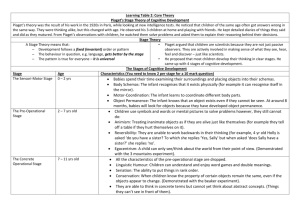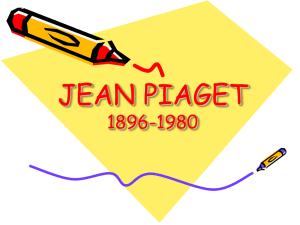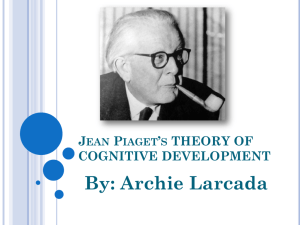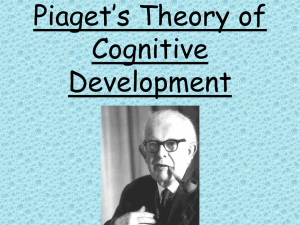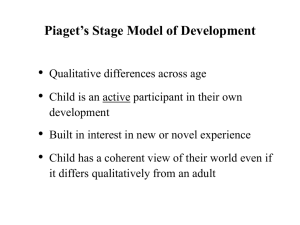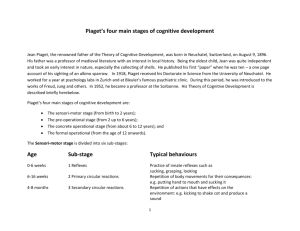Cognitive Development
advertisement
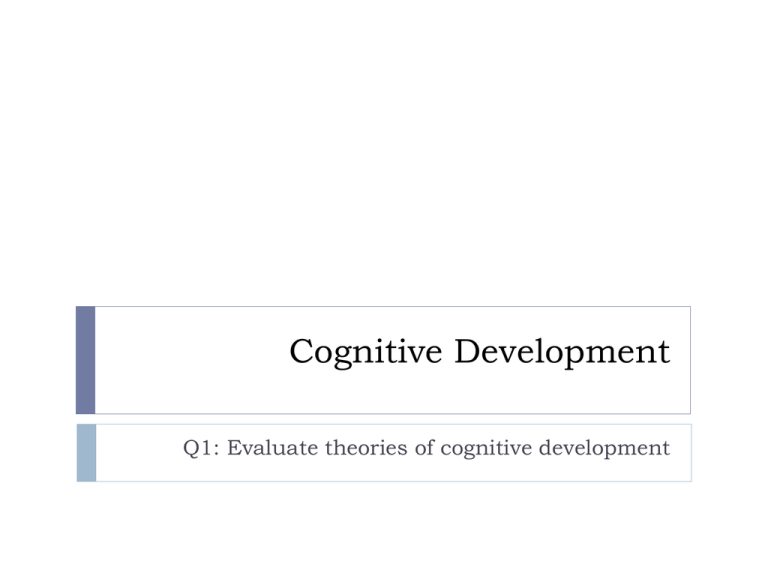
Cognitive Development Q1: Evaluate theories of cognitive development Approach Intro Background- cognitive development Thesis- evaluate command term Body- strengths and limitations of each theory Piaget- stages Vygotsky- social and cultural factors Neuroscience- biological factors Conclusion- summarize key points Introduction Cognitive development-social, environmental and genetic influence Maturation- the unfolding of behaviors that are genetically programmed Learning-changes in behavior, thoughts, and feelings as a result of experience Main debate- how these changes occur over time Nature- effects of maturation Nurture- effects of the environment The unfolding of behaviors under the influence of genetic predisposition Diet, parenting styles, culture, education Thesis: Constructivist, social constructivist, and neuroscientific theories all contribute to the understanding of cognitive development Jean Piaget’s theory (Constructivist) Knowledge develops through schemas Assimilation- new events fit existing schemas (doggie- poodle to doggie- terrier) Accommodation-new events do not fit existing schemas and new knowledge is created (doggie to horse) Born with innate schemas which are modifies through adaptation Stages of development (universal) Sensorimotor stage (0-2) Pre-operational stage (2-7) Concrete operational stage (7-11) Formal operational stage (11+) Sensorimotor Stage (0-2 years) Lack of object permanence Object permanence develops around 8 months, but incomplete 4 months- child will not look for object 8 months-child will look for object in the last place found even if hidden somewhere else Development of full object permanence at around ages 18-24 months Pre-operational Stage (age 2-7) Operations- logical mental rules but this stage, children can’t internalize these rules and still rely on appearances Egocentrism – child can only see the world from own point of view (Mountain task) Children lack conservation- the realization that objects can remain the same despite a change in appearance (demonstrated through conservation tasks of reversibility) Classification limitation- inability to classify objects into the same groups (begins around age 4) Elementary (gr. 2)- High School Concrete operational stage (7-11) Development of rules and schemas (operations) for how the (concrete) world is ordered Development of conservation Formal operational stages (11+) Ideas and problems can be manipulated without concrete objects (abstract reasoning) Imagination and role play Reasoning If A > B > C; A > C Evaluation of Piaget Strengths 1st comprehensive theory of cognitive development Evidence Egocentrism: Mountain task and Policeman view experiment Lack of Conservation : Conservation tasks Application: Education and constructivism- children as actively engaged in understanding their world Limitations Criticism of ‘ages and stages’- findings based on interviews and observations Less focus on social and cultural factors Object permanence is more flexible than Piaget argued (Bower, 1982) and criticism of some conservation tasks (McGarrigle & Donaldson (1974)- may be demand characteristics) Lev Vygotsky - Social Constructivist Importance of social interaction, culture, language, instruction, and play in cognitive development Strengths Children make sense of the world through shared meaning and language contributes to thought & understanding Zone of proximal development- instruction from one more skilled in the task provided by scaffolding to bridge the gap between what one can do alone and what one can do with assitance Some evidence for the role of language in thought Application in education (ZPD) Limitations Not all aspects of the theory are supported Piaget- Innate maturation processes that drive cognitive development Vygotsky-Shared meaning with others communicated through language and interaction Neuroscience and neuroplasticity Synaptic growth most significant in the first year and growth continues throughout adolescence Changes in brain structure Strengths Chugani, 1999)- PET scans of newborns showed increased glucose metabolism in different regions over time-from brain stem and thalamus (reflexes) to higher level functioning such as frontal lobe development Doubles in size from birth to young adulthood Similar to animal research (Rosensweig, 1972) Application- importance of a healthy environment Limitations Correlational research- no cause and effect Still many unanswered questions about cognition
